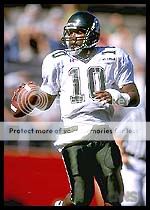Top 25 Players: #3
Part of putting together this list is realizing the 1998 campaign was no miracle. It was not a series of inexplicable events. It can be rationalized.
There were three key drivers. First, the transition from major regional independent to C-USA was not complete. The top half of the roster was still Buddy Teevens’ band from the independent days. Sure, Buddy lost almost all recruiting battles- but he lost them to other regional independents and second tier SEC programs: Mississippi, Florida State, Louisville- not C-USA dreck. As is today, the leftovers from the SEC were still materially better than C-USA base talent.
Second, Tommy Bowden successfully identified the new League’s chief strength and weakness- the surplus of smallish speed on the offensive perimeter (size seems to run out before speed at WR) coupled with the total lack of defensive secondary players who could cover. Since these factors exactly complimented one another- exponential change was possible.
But the third success criteria required identifying the quarterback who could tie this new attack all together. The player who could mentally internalize a whole new approach, physically deliver the needed performance and emotionally keep the team going despite reasons to be satisfied.
3. Shaun King, QB (1995-1998)
 Shaun King is the MVP of Tulane football of the past 25 years. I honestly don’t think there is disputing that. He leveraged the aforementioned mental, physical and emotional tools in to a great two year run. That same two year run probably generated the sufficient good will to allow athletics to survive the betrayal that was Cowen’s secret athletic review.
Shaun King is the MVP of Tulane football of the past 25 years. I honestly don’t think there is disputing that. He leveraged the aforementioned mental, physical and emotional tools in to a great two year run. That same two year run probably generated the sufficient good will to allow athletics to survive the betrayal that was Cowen’s secret athletic review.King did play quarterback for Teevens, but it was his role as C-USA’s first cartoon number generator that marks him an iconic League figure. King inherited not only a whole new offense but a whole new offensive philosophy. It wasn’t just understanding a whole new set of plays- but a whole new football calculus: when do you take risk?
For example, Bowden threw out everything we are taught to think about first down. First down was no longer about setting up a future convertible down and distance equation. Instead, Tulane was looking to punish the defense via the pass on the one down where extra defensive backs were on the bench. 2nd and 10 was sometimes better than 2nd and 5- if it meant you had King take a shot for a bigger opportunity. The football IQ required was off the charts.
And it obviously worked. King is second on Tulane’s all-time passing lists for yards, completions, touchdowns. He still leads Tulane in career total offense and total touchdowns scored. But the undefeated season was his crowning college achievement. From his official Tulane bio:
King… had a pass efficiency rating of 183.3, which broke the NCAA single season record of 178.8 set by Danny Wuerffel. King completed 68 percent of his passes (223-of-328) to go along with 36 touchdowns and just six interceptions…. also became the first player in Division 1 A history to pass for 3,000 years (3,232) and rush for 500 (532) in an 11-game season. King finished the regular season with 168 consecutive pass attempts without an interception.The other important point about King is that Tulane was not a perfect offense in 1998. There weren’t many great players- only one other offensive teammate made first team all C-USA (Bernard Robertson), and no skill player did. Even King’s raw ability wasn’t off the charts; his eventual NFL professional play showed the limits of his frame and arm.
But I write here on Frank Helps You Think It All Out about being “quarterbacky”- a sort of intangible ability to “get” the possession passing offense. And that is what King had- he could overcome the imperfections of both himself and teammates by throwing good balls, accurately, completely within the context of the exponential advantage Bowden gave him. Not only did he complete 68% of his career passes, but just as importantly completed those 68% to the right guys in the right situations.
Forget about the all-decade C-USA team, he is still the most important player in C-USA history- one of those few guys who changed an entire League. Drafted in the second round by Tampa Bay, he had some success as NFL quarterback. He joined a good team, good situation and good coach (Jon Gruden). But ultimately, being a distribution quarterback is hard in the NFL. You can play the risk-reward game, but ultimately there needs to be some base level of reward. It is a quarterback league, good quarterbacks have to make big plays. And King never had the arm to be a true drop-back weapon- just could never generate enough 20-, 30- yard plays downfield- to turn himself into a franchise asset.
Labels: Tulane Top 25 Players




<< Home